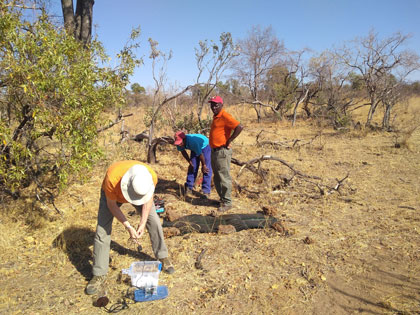African elephants are social animals that use sound and vibrations to communicate and keep tabs on each other. But their conversations aren’t anything like the high-pitched trumpeting sound that we commonly associate with these animals—those calls are reserved for signaling imminent danger or alarm. More often than not, elephants communicate using powerful, low-frequency vocalizations known as rumbles. Rumbles fall outside the threshold of human hearing, but other elephants can detect them over very long distances.
Seismic communication opens the possibility of monitoring elephants using seismic sensors, which is very appealing for biologists and conservationists.
Rumbles are so powerful that they resonate with the ground, producing seismic waves that travel farther through land than through the air. Other elephants can feel these vibrations at distances up to 6 kilometers from the source, maybe more. They pick up these vibrations with their sensitive feet, where they have special organs to help them do just that, earlier research has shown. Elephants use rumbles to locate each other, detect friendly or rival calls, and find mates. They can also feel other elephants running or stomping their feet, telltale signs of danger or threats.
Researchers call this seismic communication, and it opens the possibility of monitoring elephants using seismic sensors, which is very appealing for biologists and conservationists alike. It offers a way of keeping tabs on the animals without the hassle and risk of other methods such as radio collars or tags, which require chasing and tranquilizing the animals.
The main drawback of this approach, though, is that conventional seismic or geophysical sensors cost tens of thousands of dollars.
Raspberry Shake & Boom
The cost is why last October a group of researchers including Oliver Lamb, a geophysicist at the University of North Carolina at Chapel Hill, traveled to South Africa to test whether scientists could use a low-cost seismic sensor called Raspberry Shake & Boom (RS&Boom) to monitor elephants in the field.
RS&Boom is based on Raspberry Shake, an affordable seismograph powered by the popular Raspberry Pi technology. RS&Boom includes an acoustic microphone and a geophone—a device that converts ground vibrations into measurable electronic signals—and researchers can buy one for less than $1,000.
Lamb and his colleagues installed five RS&Boom devices at Adventures with Elephants, a 300-hectare natural reserve home to seven African elephants. Their goal was to record noisy bonding episodes known as “reunions,” where elephants rumble and stomp the ground after being separated for a while.
Their test succeeded only in part. Although the acoustic microphones on RS&Boom clearly recorded intricate details of low-frequency vocalizations, the geophones detected only rumbles produced within a 100-meter range and footsteps within a 50-meter range from the elephants. The new work is currently under review by the journal Bioacoustics.
Although the range of the RS&Boom is very limited, Lamb thinks that the devices could be used in areas where the elephants are known to congregate, such as watering holes. In theory, the vocalizations were recorded with enough clarity that specialized software should be able to differentiate between animals and tell how many different animals are present, said Lamb in a presentation at EGU2020: Sharing Geoscience Online, the 2020 General Assembly of the European Geosciences Union.
Learning Curve
Lamb is confident that a more refined field setup could yield better results.
To protect RS&Booms from the elements, Lamb and his team tucked each device inside a plastic container and buried it 30 centimeters in the ground. Since the acoustic sensors rely on direct measurements of the atmosphere, they poked a hole in each container and introduced a hollow tube running from the container to the surface. Large car batteries connected to solar panels powered these contraptions.

“It wasn’t the best way to deploy the sensor, but it was the best we could do,” Lamb said. “The best way to deploy the sensor would be to build a large concrete vault, at least 1 meter into the ground. That just wasn’t viable for the temporary field experiment we were doing.”
Tarje Nissen-Meyer, a geophysicist at the University of Oxford in the United Kingdom, has also used seismic sensors to study elephants in the field but was not involved in the current study. According to Nissen-Meyer, the capability to detect seismic signals from wildlife at long distances strongly depends on many variables, including local soil and geology, vegetation, topography, ambient noise, and, crucially, the coupling of the recording device to the ground.
“Only under very favorable conditions can one expect signals to be detectable at far distances,” Nissen-Meyer said. “In that sense, I entirely agree with their plans to run a new project with better instrument coupling.”
Automated Monitoring and Early-Alarm Systems
Seismic systems could be used to detect poachers or as an early-warning system when elephants leave protected areas or get too close to human settlements, crops, or cattle.
In their paper, Lamb and colleagues hint at the possibility of developing an automated system based on seismic detectors that could autonomously track and send alarms about elephant activities. Such systems could be used to detect poachers or as an early-warning system when elephants leave protected areas or get too close to human settlements, crops, or cattle.
Although it’s theoretically possible, “we are not in a position to implement an automated system with reliable accuracy at this point, at least as far as I am aware,” Nissen-Meyer said. “However, we are not starting from scratch, by building on hardware and software advances from other fields.”
For instance, Nissen-Meyer argues, biologists have used low-cost acoustic sensors with success before. On the software and methodological side, such methods shouldn’t be much different from those used for earthquake seismology or nuclear monitoring. It would be a matter of adapting existing technologies in seismic modeling, source inversion, and machine learning. “We are nowhere close to having a system or even proof-of-concept at hand, but the very fact that seismic signals are detectable is enough to inspire us to dig deeper,” he said.
—Javier Barbuzano (@javibarbuzano), Science Writer
9 June 2020: This article has been updated with a correction to reflect that some Raspberry Shake & Booms are suitable for outdoor use.
Citation:
Barbuzano, J. (2020), Monitoring African elephants with Raspberry Shake & Boom, Eos, 101, https://doi.org/10.1029/2020EO144604. Published on 28 May 2020.
Text © 2020. The authors. CC BY-NC-ND 3.0
Except where otherwise noted, images are subject to copyright. Any reuse without express permission from the copyright owner is prohibited.

